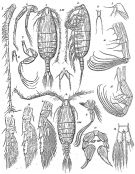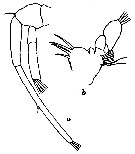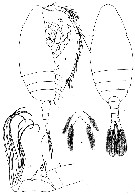|
|
 |
|
Calanoida ( Order ) |
|
|
|
Arietelloidea ( Superfamily ) |
|
|
|
Arietellidae ( Family ) |
|
|
|
Paraugaptilus ( Genus ) |
|
|
| |
Paraugaptilus meridionalis Wolfenden, 1911 (F,M) | |
| | | | | | | Syn.: | Paraugaptilus buchani : Sars, 1925 (p.336); Rose, 1933 a (p.242: figs.F,M); Vives & Shmeleva, 2007 (p.166, figs.F,M); ? C.B. Wilson, 1950 (p.275, figs.F) | | | | Ref.: | | | Wolfenden, 1911 (p.353, figs.F); Sewell, 1948 (p.505); Deevey, 1973 (p.254, Rem.); Bradford, 1974 a (p.524, Rem.) |  Issued from : G.O. Sars in Résult. Camp. Scient. Prince Albert I, 69, pls.1-127 (1924). [Pl.CXXI, figs.1-18]. As Paraugaptilus buchani. Female (from W Canary Is. & Azores): 1, habitus (dorsal); 2, idem (lateral left side); 3, forehead (lateral); 4, rostrum; 5, A1; 6, A2; 7, left Md; 8, right Md (masticartory edge); 9, Mx1; 10, Mx2; 11, Mxp; 12, P1; 13, P2; 14, P3; 15, P5. Nota: Head equal ½ prosome length and ending by a obtuse spurt. Rostrum as small and narrow tongue-like with 2 long thin filaments. Posterior lobes of the last pedigerous segment reduced, truncated, do not pass beyond the beginning of the genital segment. Urosome equal 1/3 prosome length. Genital segment short,about the length of the two following segments together, slightly swollen bfore the middle. Caudal rami large, about 2 times length than wide, outer edge naked, inner edge with fine hairs. ; Setae relatively short, little unequal, all with ciliary. A1 pass just beyond the prosome length. A2 with the endopod very thin, 2 times the exopod length, the length of the distal segment pass considerably the proximal. Mx1 with outer lobe short and thick, bearing 5 spines at the extremity, diminishing successively in length inside, epipodite with 6 setae, endopod naked at the ending and the little endite at base without apical seta. P5, rudimentary, each leg bearing 1 terminal ciliated seta and 1 short seta outside. Male: 16, habitus (dorsal); 17, P5; 18, anal segment and caudal rami (dorsal). Nota : P5 asymmetical, the left leg more strong, 3-segmented, bearing on the distal segment 2 movable spines forming a grip. Endopods rudimentary, the left little more large than the right, with a slight bilobated indication at the extremity.
|
 issued from : R.N. Wolfenden in Die Marinen Copepoden der Deutschen Südpolar-Expedition 1901-1903, 1911. [p.354, Fig.81]. Female (from Cape Verde Islands): a, A2; b, Mx1.
|
 issued from : R.N. Wolfenden in Die Marinen Copepoden der Deutschen Südpolar-Expedition 1901-1903, 1911. [Pl.XXXIX, Figs.1-4]. Female: 1, habitus (lateral); 2, idem (dorsal); 3, Mx2; 4, P5.
| | | | | NZ: | 3 + 5 doubtful | | |
|
Distribution map of Paraugaptilus meridionalis by geographical zones
|
| | | | Loc: | | | Atlant. (off W Cape Verde Is., Canary Is., Azores, W Ireland), California, ? New Zealand, ? Philippines, ? Alaska, ? off Peru | | | | N: | 3 | | | | Lg.: | | | (1) F: 3,3; (10) F: 2,9; (1132) M: 2,8; {F: 2,90-3,30; M: 2,8} | | | | Rem.: | The confusion between this species and P. buchani makes the geographic locality records uncertain. See remaks from Deevey (1973, p.254) concerning the similarity between the two species.
Furuhashi (1965, p.23) reports this form in the seas surrounding Japan. | | | Last update : 05/02/2015 | |
|
|
 Any use of this site for a publication will be mentioned with the following reference : Any use of this site for a publication will be mentioned with the following reference :
Razouls C., Desreumaux N., Kouwenberg J. and de Bovée F., 2005-2025. - Biodiversity of Marine Planktonic Copepods (morphology, geographical distribution and biological data). Sorbonne University, CNRS. Available at http://copepodes.obs-banyuls.fr/en [Accessed August 17, 2025] © copyright 2005-2025 Sorbonne University, CNRS
|
|
 |
 |






